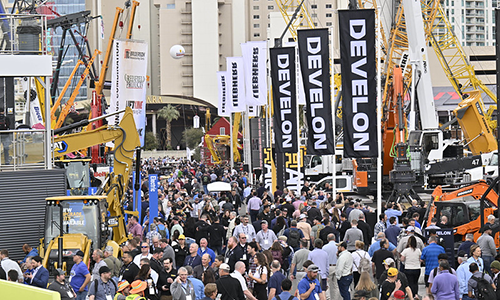Many would agree that a transformation of the construction industry has already commenced. Technology is changing the way buildings are designed, equipment operates and organizations function. Renewable energies are being leveraged more often and in more ways.
A Vision Team and Futures Council spent countless hours discussing how these influences, among many others, could transform the construction industry over the next decade, and shared their insights and perspectives in AEM's recently released Future of Building whitepaper.
Volvo CE's Ray Gallant, HUSCO International's Brad Kramer and Cummins's Jeremy Harsin also joined Erica Baird of Cummins for a panel discussion on some of the trends discussed in the whitepaper, what is top-of-mind for them as it relates to the future of the construction industry, and more, at AEM's Annual Conference late last year.
Below are some excerpts from the discussion.
Baird: How would each of you define what electrification means for you and your company?
Kramer: As we think forward to electrification, and truly just burning less greenhouse gases in our industry, there are two things that we are thinking about right now. One Is the change associated with the power plant. From HUSCO International's side, we are really worried about the energy management downstream of the power plant and converting that to the precise work of the machine.
That overlaps with another trend that has really been accelerating, which is the trend toward automation in our industry. But they’re really coupled together. Machines are becoming more automation ready. We’re seeing software and electronic controls to drive our machine. Thar allows us to manage the energy at a much higher level and really rethink about how we direct some of that energy. The second part of it is, by doing the work more productively as we move to automation, it will lead to lower greenhouse impact.
Harsin: From our perspective, I think electrification is part of a bigger story. Like a lot of companies, Cummins has goals that we have set for 2030 that are a lot more tangible and measurable. Greenhouse gas reduction from what is both coming out of the plant new and from what we are going to be releasing in the near future.
If you look in the long term, we don’t typically play in what people call the compact space. But electrification is not just about batteries, it’s part of a bigger solution set. We do think, in a lot of the markets we serve, if you’re thinking 2040 or 2050, fuel cells and other technologies are going to come in and play pretty strong. If you think about all the things that need to happen between now and then, electrification is more than just a battery, it's about all the stuff that goes into the equipment that helps work done a little more efficiently. It's part of a set of different things that are going to set us up for what we want to do between now and 2050, as we march down that path together.
Baird: Why are we seeing, or not seeing, a demand for electric in machines today?
Gallant: I think it's a transfer, and a transition to, new technology. So, throughout the industry, especially when you get into the more exotic technologies, such as hydrogen fuel cells and hydrogen combustion, they are not ready to go mass market today, and that’s primarily because of the refueling sources. So, we could build a machine that runs off of fuel cell for instance, but where do you get the hydrogen to power it?
So, that is what’s really driving the demand and the speed of demand uptake. Now having said that, the demand, from an innovation point view, the demand curve is exactly what I would expect. It's the early adopters coming into the field and picking up these early technologies for their unique uses, and they are finding unique ways to use that equipment to take advantage of the features that electric equipment has, especially noise. A lot of applications come out where the machines are quiet, have low vibration and low emission. So, customers are finding uses for them that they couldn’t do with the diesel equipment.
Kramer: We are still very early in the transition, and as an industry, we aren’t the automotive industry. The environmental requirements of our equipment, the usage, the need for reliability, and uptime at all times, are going to drive different challenges. So, I think we will learn as we introduce machines to the market, what markets they serve well, and where we must innovate to make transitions.
Baird: When you think about regulations and what’s driving the industry right now, or this demand, would it be the regulations and ESG pressures to decrease the carbon footprint, or would it be customers?
Kramer: I think there are pockets of customer usage now, as more machines start to launch. Noise is a real thing, and we're starting to hear that back from customers, the reduction of noise on electric equipment and the emissions. There are markets that are probably going to be adopters first. In building usage of machines, cities where noise and access to refueling or plugging in is much shorter.
Think of an analogy of the fork truck industry. They switched because of customer demands quite long ago, and it found a marketplace, but it wasn’t ubiquitous, either. A portion of the industry moved on customer demand. I think of the customers specifically in Europe and North America, as we as we look at what is driving them, it's the 2030-2035-type of ESG goals that they have and where they are trying to structure their fleets into lowering their greenhouse gas impact, and all with an eye on regulation. I think we look at California and other regions of the world, and we know that regulations will be coming.
AEM Annual Conference is the place for member executives to examine what is ahead for their organization and the equipment manufacturing industry. Attended annually by senior executives and the next generation of leadership in the off-road equipment manufacturing industry, this is the industry’s can’t-miss gathering. Learn more.
Baird: When you think about the full scope of what’s next and how we’re going to span the full scope of equipment, what do you think is next?
Harsin: I would say for sure don’t count out diesel. We fully expect another round of development that is probably going to happen at the end of the decade, give or take a couple years. Even where battery and fuel cell are probably going to win out in a lot of cases in the long run, I think the diesel market is far from done. Consider the advancements and fuel consumption, and a lot of different characteristics of the engines themselves. Then think about connectivity, efficiency benefits and a lot of these other things that we can do now. I think that’s going to be the next seven or eight years of work.
From our perspective beyond that, one that we’re pretty excited about is hydrogen combustion, so we have been pretty public about what we call a fuel-agnostic platform. And that all kind of roots back into scale. So, it is base engine and a lot of the after-treatment components. If you think about an engine that can burn diesel, natural gas, or hydrogen as a fuel, you can get scale on maybe 60-70% of that material within the decade. So, that's going to go a long way to help bring those costs down. Not down to where diesel is today, but I think it's going to be closer.
Kramer: Tying back to the regulation question we just talked about, there are regulations on the machines coming forward definitely, but there are also regulations on the energy generation in terms of how we modernize the grid and how we take it to more renewable energies moving forward. So, I think that is going to play a part in it.
And as far as the new technologies coming out, we look at it in terms of (several) different technology sets that are going to come together and produce part of the solutions for this problem going forward. We don’t believe that any one technology is the magic silver bullet that is going to solve this whole thing; it just doesn’t exist, that’s the reality. So, we’re looking at a number of different technologies, starting on the small equipment.
Finally, overriding all of these is we have to be much smarter with the energy management. How do we use less energy and get the jobs done in a more productive way? Diesel fuel has been cheap for 100 years, we have an infrastructure built up, it is very easy to consume diesel fuel, and as a result, as an industry probably were not as efficient using the energy as we should’ve been. So, now that has got to change. We must be more energy-efficient and energy-minded, managing the energy properly if we’re going to bring in these new technologies and make them work in a viable and productive way.
Baird: What would the phase in process look like?
Gallant: This is not something that is going to happen tomorrow. You don’t flip a switch and diesel engines go away and get replaced by electric drives or these new technologies. Some of these technologies are four or five years out. I do see an encouraging trend where the technologies, even the more exotic technology, the pathway is there for 2030. You'll see hydrogen machines long before 2030 in the marketplace. The issue is that we need the enablers, which are the fueling sources and the way to transport and store the hydrogen to make those machines work, but we'll see the first machines start to emerge between now and 2030.
The other enablers are the regulations and the structure for society to recognize that they need to make the transition in the electrical generation, and in the storage and movement of these energy sources around. I think those are the two thinks that have to happen. The easier part is the machines, the more difficult part is going to be doing everything to make those machines work, along with changing the site dynamics as well.
Baird: What requests are you seeing from customers, and what does the redesign entail in the turn on investment?
Kramer: We have things ready today to manage the energy on machines better and more productively, and we’re seeing acceleration in the trend of using some of those things. It’s both with true energy conversion, but then also how to do the machines smarter, do the work smarter itself. It’s a converging trend where we have sensors and high-fidelity controllers and other electronics that we can start to be smarter with what we do with machines. That technology is available today, and when I see the requests from the OEMs, it’s to get started. I think another encouraging trend is that we are already starting to have partnership level discussions with a lot of our OEMs about ‘What does your pathway look like on these machines, not just for the next generation, but for two generations after that and the generation after that?’ as we look at the transformation, and the flip of a switch cannot be full machinery design, some of these things we need to step into.
Harsin: Diesel has, I believe, spoiled us a little bit over the last 100 years or so. It does the job really well, it fits in packages really nicely. Most of the requests or conversations that we have about where some of this technology is at, I think people are maybe a little bit too high-hope level for what they’re going to be able to do into something that’s not a diesel really quickly. The question is, ‘Can you just pull out the engine in the after-treatment and put the other thing in?’ and the response is usually, ‘Man, I really wish.’ But it just doesn’t work like that. There are volume considerations that come in when you think about getting the right amount of energy on board and still being able to see. I think it goes along with some other trends we see, if you look at some of the equipment, you start to see the people who are jumping in early using real estate they hadn’t used in the past, such as batteries, tanks or other things. I think there’s a lot of that conversation that happens, I think everybody more or less wants to do something. I think a lot of people just aren’t sure what that is yet.
We have a lot of planning and road mapping conversation that we tried to guide folks through. The easy thing or the immediate thing that people generally want to do is jump straight to a demonstration vehicle. Those are good in some cases; in a lot of cases, it’s maybe a one off, and the engineering lift at this point is pretty heavy. So, we have a lot of the conversation of whether it’s needed right now or if it is something we can plan out a little bit better.
Gallant: No one company is going to own all these different technologies or have the core competence in all these technologies to pull this off. We’re in a position at Volvo where we’re talking to companies lie AT&T and Verizon on connectivity. That's not a normal company that we would partner with 10 years ago, but now it is a crucial part of this going forward to understand how that connectivity works. It’s not our core competence, but we need to understand how that works and how to build machines and processes and systems on the site that take advantage of that. So, I think when we say partnership is the new leadership, that is very true when you are talking about this space. One company is going to own it, and every one of you and your company’s going to have to figure out what is your position in this going forward. Do you want to be a leader in this particular technology, do you partner with this particular company and they’re the leader? How do you want to position yourself going forward. And every one of us is going to have to make those decisions and discussions in our companies.
Kramer: I think, just to carry on from the partnership level, as a component supplier, we need to be collaborating at the OEM level. When we look at the different road maps across the industry and machine types, it is not a one size fits all. So, as we think of capitalizing into the next 10 years, we want to make sure we’re developing the right components across that spectrum of solutions. So, having real honest conversations, it’s not commodity buying product cards anymore, it is real collaboration at the component-to-OEM level.
Subscribe to the AEM Industry Advisor for more perspectives on issues important to the equipment industry.





